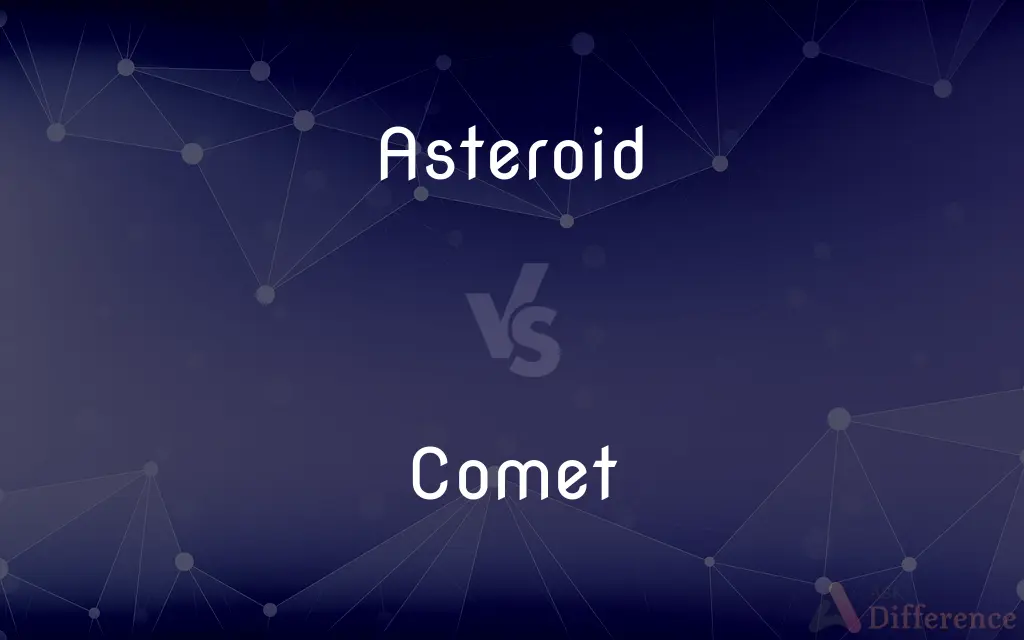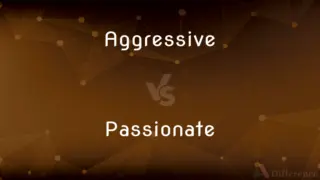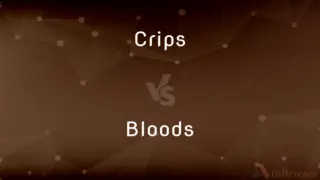Asteroid vs. Comet — What's the Difference?
By Tayyaba Rehman — Updated on September 22, 2023
An asteroid is a rocky body orbiting the sun, primarily found in the asteroid belt between Mars and Jupiter. A comet, composed of ice, dust, and rocky material, develops a glowing tail when approaching the sun due to solar radiation.

Difference Between Asteroid and Comet
Table of Contents
ADVERTISEMENT
Key Differences
Asteroids and comets are celestial bodies that intrigue astronomers and space enthusiasts alike. An asteroid is predominantly a rocky object that orbits the sun. These objects are remnants from the early solar system and are mainly situated in the asteroid belt, a region located between the orbits of Mars and Jupiter. Due to their composition, asteroids do not have tails and usually don't produce visible outgassing.
Contrastingly, a comet is a mixture of ices, dust, and rocky matter. Originating from the cold outer regions of the solar system, such as the Kuiper Belt and the Oort Cloud, comets travel on highly elliptical orbits. As a comet nears the sun, its ices begin to sublimate, causing it to develop a glowing coma and often a tail that points away from the sun, due to the solar wind and radiation pressure.
While asteroids primarily consist of rock and metal, comets embody volatile compounds like water, ammonia, and methane. These volatile compounds in comets are the reason for their spectacular display when they come closer to the sun. The sublimation of these compounds causes the iconic illuminated tail, a feature that asteroids do not possess.
Interestingly, the categorization of some celestial bodies as either an asteroid or comet can occasionally blur. Some asteroids exhibit comet-like activity, and these are termed "active asteroids." Conversely, some comets that have lost most of their volatiles might resemble asteroids.
Despite some overlaps, asteroids and comets remain distinct in their formation, composition, and behavior. Their study provides invaluable insights into the history and dynamics of our solar system.
ADVERTISEMENT
Comparison Chart
Primary Composition
Rock and metal
Ice, dust, and rocky material
Location
Mainly asteroid belt between Mars & Jupiter
Kuiper Belt, Oort Cloud, and elliptical solar orbits
Tail Presence
No
Yes, when near the sun
Orbital Shape
More circular or slightly elliptical
Highly elliptical
Activity
Mostly inactive
Develops glowing tail and coma near the sun
Compare with Definitions
Asteroid
Most are found in the space between Mars and Jupiter.
The asteroid belt contains countless asteroids, with some being quite large.
Comet
Has a highly elliptical orbit around the sun.
Due to its elliptical orbit, the comet only approaches the sun once every century.
Asteroid
A small rocky body orbiting the sun.
Scientists are keen on exploring the asteroid Ceres for potential clues about our solar system.
Comet
A celestial body made of ice, dust, and rock.
Halley's Comet is one of the most famous comets, visible from Earth every 76 years.
Asteroid
Remnants from the early solar system.
Studying asteroids can provide insights into the early building blocks of planets.
Comet
Develops a glowing tail when near the sun.
The bright tail of the comet could be seen stretching across the night sky.
Asteroid
Primarily composed of rock and metal.
The metallic composition of some asteroids makes them a potential mining target.
Comet
Originates from the outer reaches of the solar system.
Many comets are believed to come from the distant Oort Cloud.
Asteroid
Lacks an observable coma or tail.
Unlike a comet, an asteroid doesn't produce a tail when it approaches the sun.
Comet
Sublimates its ices producing a visible coma.
The comet's coma shone brightly as it got closer to the sun.
Asteroid
An asteroid is a minor planet of the inner Solar System. Historically, these terms have been applied to any astronomical object orbiting the Sun that did not resolve into a disc in a telescope and was not observed to have characteristics of an active comet such as a tail.
Comet
A comet is an icy, small Solar System body that, when passing close to the Sun, warms and begins to release gases, a process that is called outgassing. This produces a visible atmosphere or coma, and sometimes also a tail.
Asteroid
(Astronomy) Any of numerous small solar system bodies that revolve around the sun, with orbits lying chiefly between Mars and Jupiter and characteristic diameters roughly between one and several hundred kilometers. Also called minor planet, planetoid.
Comet
A celestial body, observed only in that part of its orbit that is relatively close to the sun, having a head consisting of a solid nucleus surrounded by a nebulous coma up to 2.4 million kilometers (1.5 million miles) in diameter and an elongated curved vapor tail arising from the coma when sufficiently close to the sun. Comets are thought to consist chiefly of ammonia, methane, carbon dioxide, and water.
Asteroid
(Zoology) See starfish.
Comet
(astronomy) A small Solar System body consisting mainly of volatile ice, dust and particles of rock whose very eccentric solar orbit periodically brings it close enough to the Sun that the ice vaporises to form an atmosphere, or coma, which may be blown by the solar wind to produce a visible tail.
Asteroid
Star-shaped.
Comet
A celestial phenomenon with the appearance of such a body.
Asteroid
(zoology) Any member of the taxonomic class Asteroidea; a starfish
Comet
Any of several species of hummingbird found in the Andes.
Asteroid
(astronomy) A naturally occurring solid object, which is smaller than a planet, larger than a meteoroid and not a comet, that orbits a star and often has an irregular shape.
Comet
A member of the solar system which usually moves in an elongated orbit, approaching very near to the sun in its perihelion, and receding to a very great distance from it at its aphelion. A comet commonly consists of three parts: the nucleus, the envelope, or coma, and the tail; but one or more of these parts is frequently wanting. See Illustration in Appendix.
Asteroid
(astronomy) In the Solar system, such a body that orbits within the orbit of Jupiter
Comet
(astronomy) a relatively small extraterrestrial body consisting of a frozen mass that travels around the sun in a highly elliptical orbit
Asteroid
A starlike body; esp. one of the numerous small planets whose orbits lie between those of Mars and Jupiter; - called also planetoids and minor planets.
Asteroid
Any of numerous small celestial bodies composed of rock and metal that move around the sun (mainly between the orbits of Mars and Jupiter)
Asteroid
Shaped like a star
Common Curiosities
Are asteroids primarily made of ice like comets?
No, asteroids are mainly composed of rock and metal, while comets have ice, dust, and rock.
Are all asteroids inactive like rocks?
While most asteroids are inactive, some "active asteroids" exhibit comet-like behavior.
Do comets always have tails?
Comets develop tails when they come close to the sun, but not when they are in the outer solar system.
What causes a comet's tail to glow?
A comet's tail glows due to the sublimation of its ices and the solar radiation when it nears the sun.
Why don't asteroids have tails like comets?
Asteroids lack the volatile compounds that sublimate and produce a tail as seen in comets.
Can asteroids be seen from Earth?
Yes, some asteroids are visible from Earth using telescopes, and a few can even be seen with the naked eye.
How often do comets return to the inner solar system?
It varies. Some comets, like Halley's, return every 76 years, while others might take thousands of years.
Is the asteroid belt dangerous for spacecraft?
Despite its many asteroids, the asteroid belt is vast, and space missions can navigate through it safely.
Where is the primary location of most asteroids?
Most asteroids are located in the asteroid belt between Mars and Jupiter.
Which comes from the Oort Cloud, asteroids or comets?
Comets, especially long-period ones, are believed to originate from the Oort Cloud.
Can a comet become an asteroid over time?
A comet that loses most of its volatiles might resemble an asteroid, but it doesn't truly become one.
Do comets pose a threat to Earth?
While comets can potentially impact Earth, they are less of a concern than some near-Earth asteroids.
Are there any asteroids near Earth?
Yes, some asteroids, termed "Near-Earth Objects (NEOs)," come close to Earth's orbit.
What's the core difference in the composition of an asteroid and a comet?
Asteroids are mostly rock and metal, while comets contain significant amounts of ice and volatile compounds.
Are there missions planned to explore asteroids or comets?
Yes, several space agencies have sent or are planning missions to study both asteroids and comets in detail.
Share Your Discovery

Previous Comparison
Aggressive vs. Passionate
Next Comparison
Crips vs. BloodsAuthor Spotlight
Written by
Tayyaba RehmanTayyaba Rehman is a distinguished writer, currently serving as a primary contributor to askdifference.com. As a researcher in semantics and etymology, Tayyaba's passion for the complexity of languages and their distinctions has found a perfect home on the platform. Tayyaba delves into the intricacies of language, distinguishing between commonly confused words and phrases, thereby providing clarity for readers worldwide.
















































